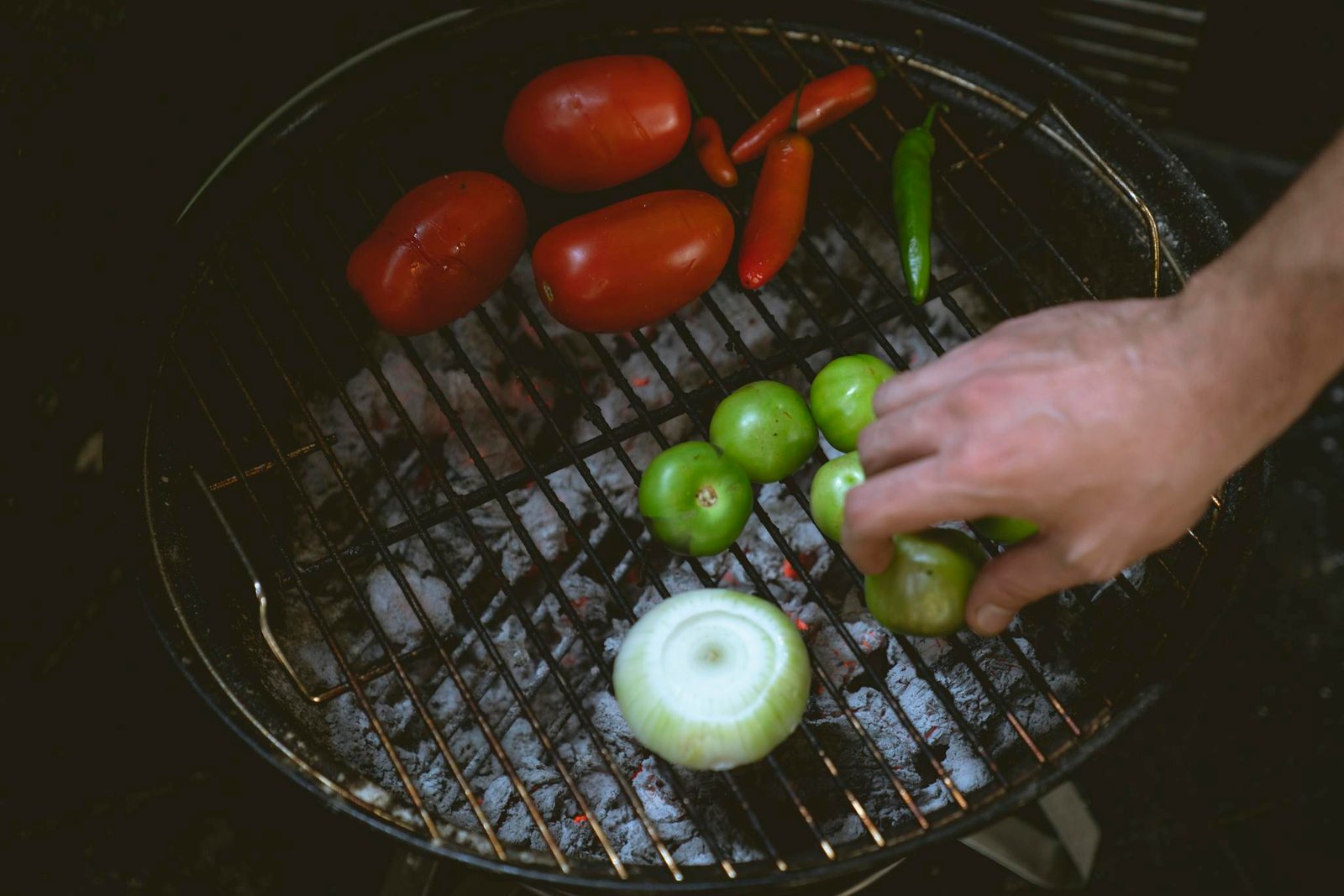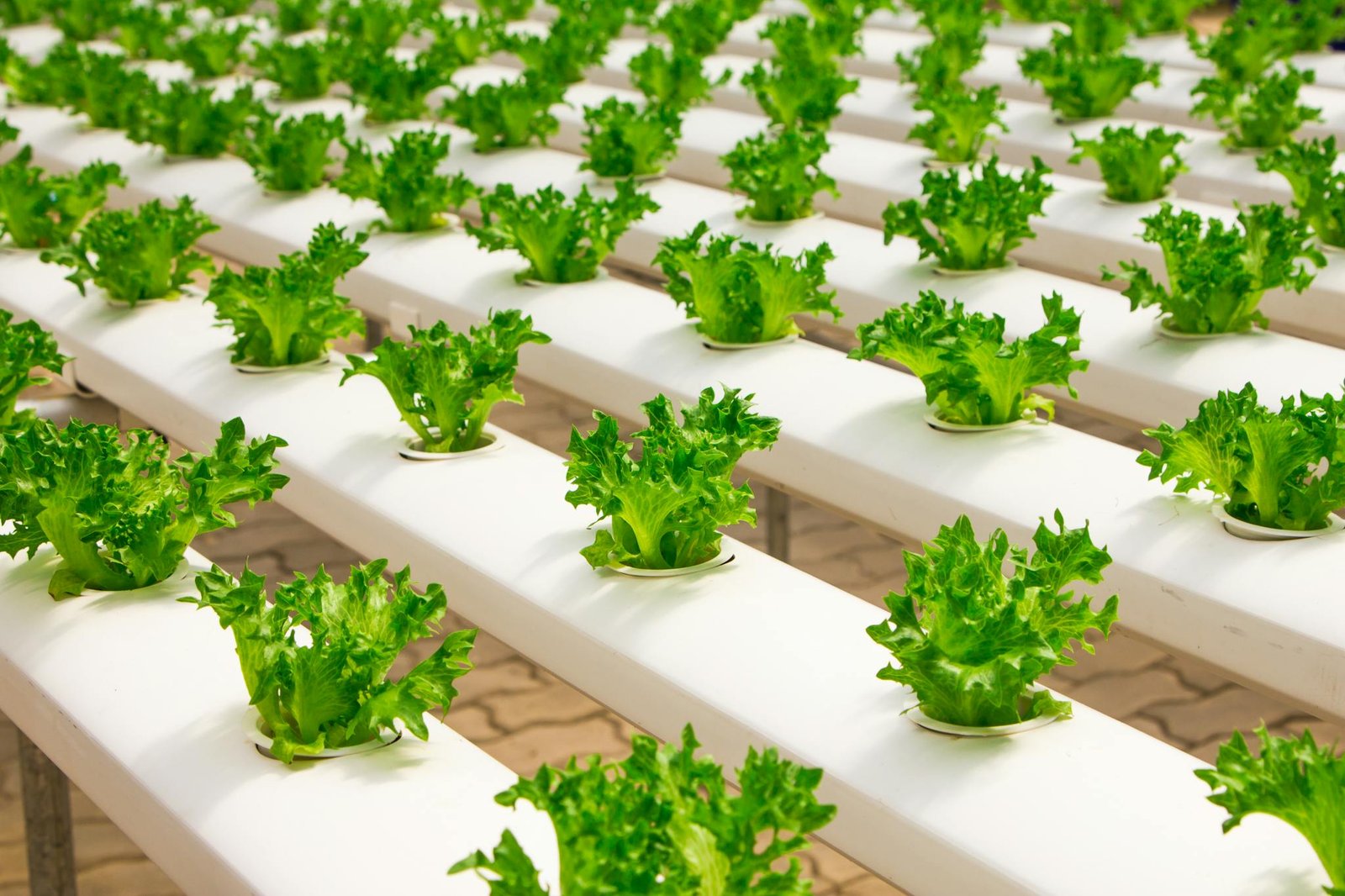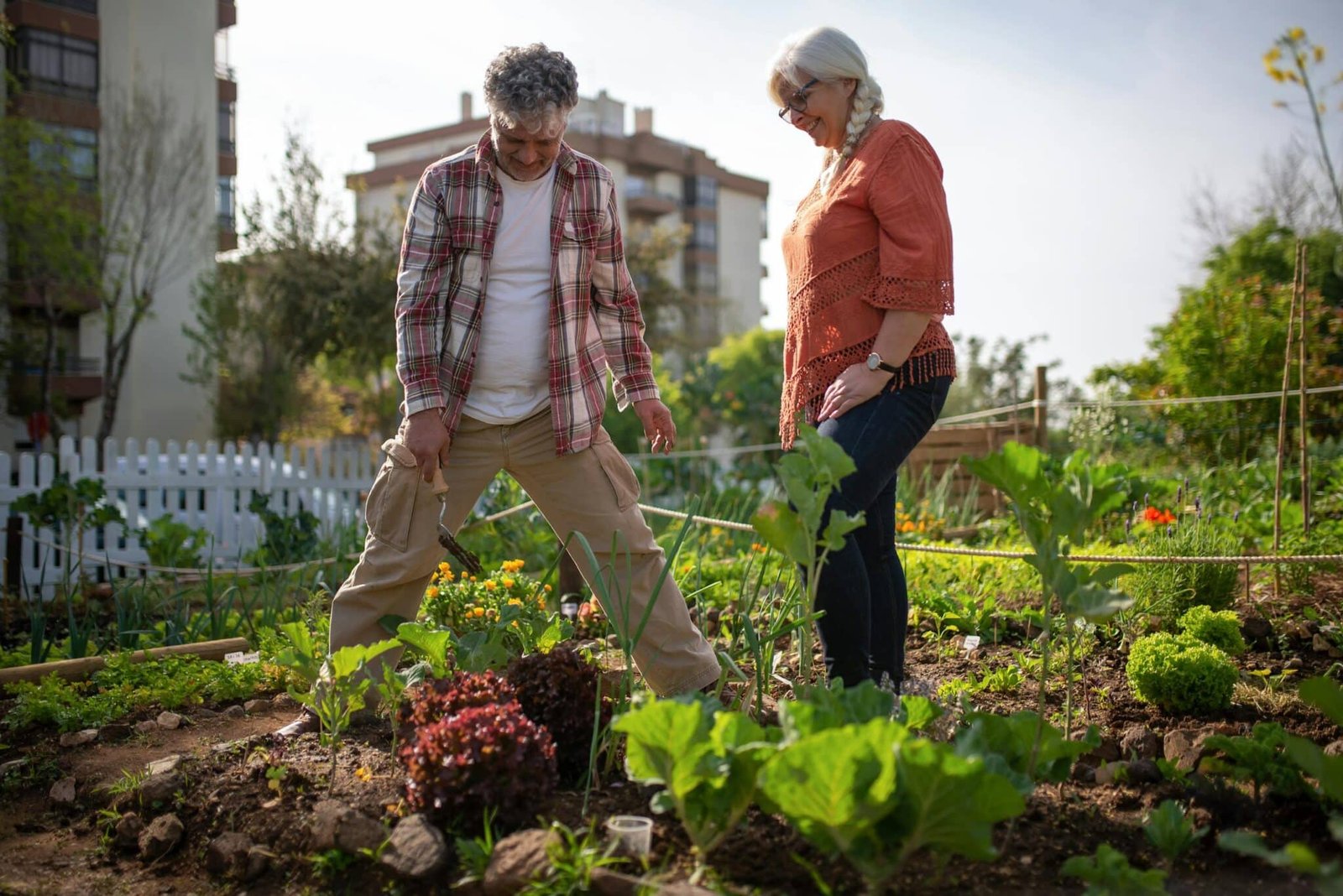10 Must-Have Features in Your DIY Raised Vegetable Garden Bed for a Bountiful Harvest!
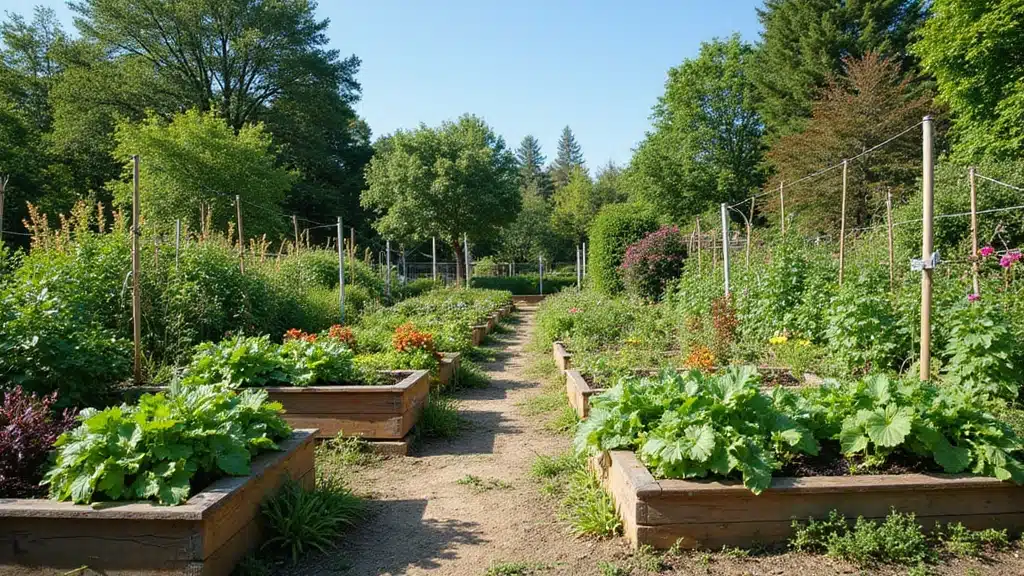
Building your own raised vegetable garden bed is not just about growing your favorite veggies; it’s also about maximizing productivity and creating a beautiful space in your yard.
With the right features, you can make your garden both functional and visually appealing. These enhancements will help boost your harvest while making your gardening experience more enjoyable. From smart irrigation systems to companion planting ideas, each feature contributes to a thriving vegetable garden. Let’s dig in and explore these essential elements that will set you up for a bountiful harvest this growing season!
1. Optimal Height for Comfort
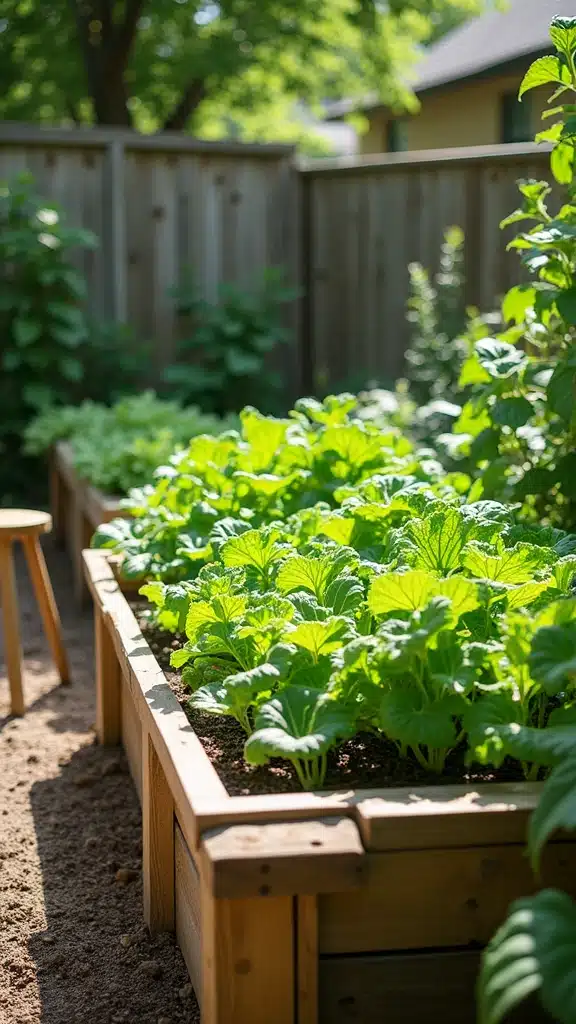
The height of your raised vegetable garden bed plays a crucial role in your gardening experience. A bed that’s too low might make it hard to bend down and tend to your plants, while one that’s too high can make watering and harvesting a challenge.
Generally, a height of 24 to 30 inches is ideal for most gardeners. This height allows you to work comfortably without too much bending or stretching. Additionally, a taller bed can help keep pests at bay and provide better drainage. To make the most of your gardening experience, consider incorporating a nearby seating area for breaks and easy access.
To enhance your bed’s height, using sturdy materials is key. Consider a raised garden bed kit made from galvanized metal. It’s durable and designed specifically for growing vegetables, ensuring your garden stands the test of time.
For optimal plant growth, ensure the interior has high-quality soil. A great option is the Miracle-Gro potting mix, which feeds your plants for up to six months and is suitable for various types of greenery.
Lastly, as you work in your garden, consider a garden kneeler and seat. This versatile product will provide comfort while tending to your plants and make gardening both productive and enjoyable.
Having the right height not only boosts productivity but also enhances the pleasure of gardening!
2. Quality Soil Mix

Soil is the heart of your garden, and using a high-quality soil mix is essential for healthy plants. A good mix should consist of compost, peat moss, and vermiculite or perlite, providing the right balance of nutrients, moisture retention, and aeration.
For a great foundation, consider adding Organic Compost. This compost and manure blend is odor-free and naturally moist, ensuring that your garden receives the essential nutrients it needs for robust growth.
Next, incorporating Peat Moss into your soil mix can significantly enhance the moisture retention and aeration properties, enriching plant roots and helping them thrive.
For improved soil structure, you might also want to include Vermiculite. This coarse material not only aids in aeration but also helps create a lighter texture that root vegetables prefer.
DIY soil blends can be tailored to the specific needs of your vegetables. For instance, leafy greens thrive in nutrient-rich soil, while root vegetables prefer a lighter texture. Always test your soil pH to ensure it’s between 6.0 and 7.0 for optimal growth.
Implementing a layering technique in your raised bed can also be beneficial:
– Start with coarse materials at the bottom for drainage.
– Add organic matter like compost for nutrients in the middle.
– Top with a light mix for planting.
Quality soil will not only improve productivity but also create a thriving ecosystem right in your backyard!
3. Irrigation Systems for Efficiency
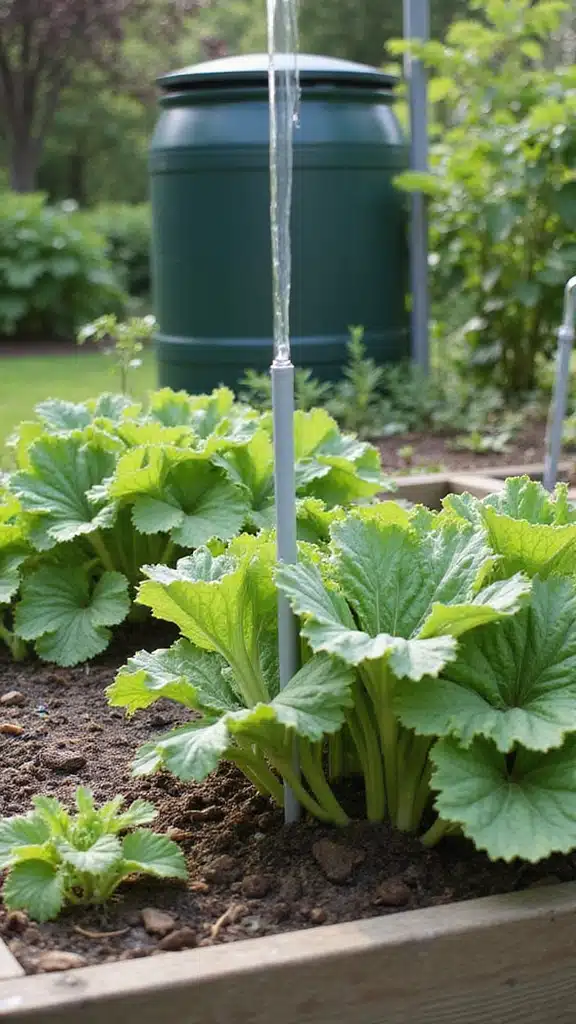
Watering can often be the most time-consuming aspect of gardening, making an efficient irrigation system a must-have feature. Options like drip irrigation or soaker hoses can save you time and ensure your plants receive consistent moisture. For instance, the Rain Bird DRIPKITBAG drip irrigation repair and expansion kit provides a reliable way to set up a drip system that delivers water directly to the roots, reducing waste and minimizing water evaporation.
Installing a simple timer, such as the RAINPOINT sprinkler timer, can help automate your watering schedule. This allows you to program the system to water your garden at specific times, giving you peace of mind while keeping your plants thriving.
Additionally, connecting soaker hoses to a rain barrel is an eco-friendly way to irrigate your garden effectively. These hoses save up to 80% water and provide a gentle, consistent moisture level.
Using mulch is also recommended to retain moisture and suppress weeds, complementing your irrigation efforts. If you have larger beds, you might also consider a sprinkler system to cover more ground efficiently.
With the right setup and products, your plants will appreciate the care you provide, allowing you to spend more time enjoying your beautiful garden!
4. Companion Planting Techniques
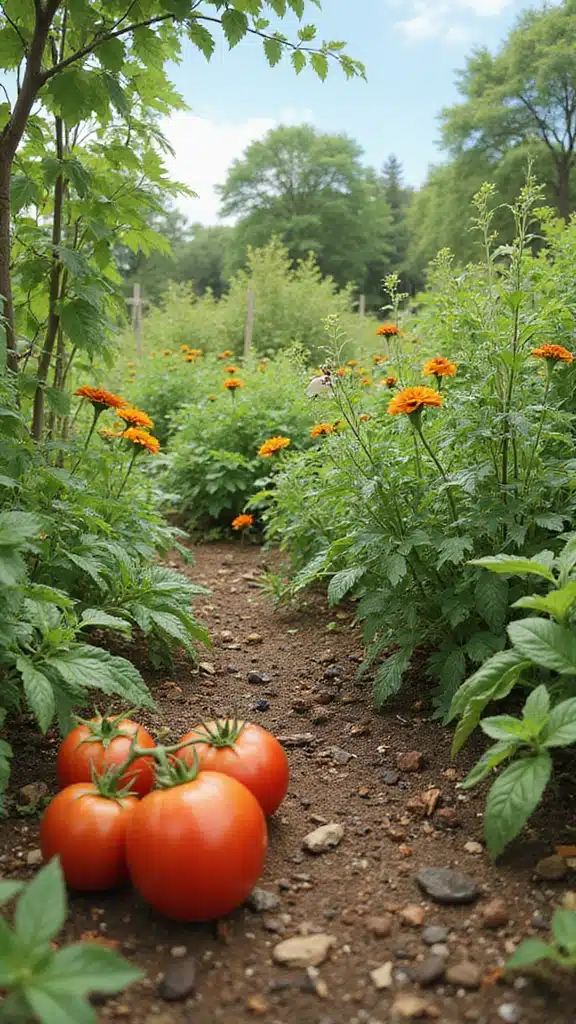
Companion planting is a fantastic strategy for increasing yield and pest control in your raised vegetable garden. Some plants thrive when grown next to certain companions, which can enhance growth, deter pests, or improve flavor.
For instance, planting basil next to tomatoes is known to enhance the tomatoes’ flavor while also repelling harmful insects. Additionally, beans fix nitrogen in the soil, which benefits neighboring plants like corn and squash.
To help you navigate the world of companion planting, consider the companion planting guide book. This informative poster details various plant pairings that work well together, making it easier to plan your garden effectively.
Furthermore, planting flowers like marigolds can attract beneficial insects, while using taller plants can provide shade for those that prefer cooler conditions. By creating a diverse ecosystem, your garden becomes more productive and healthier overall!
5. Accessibility Features
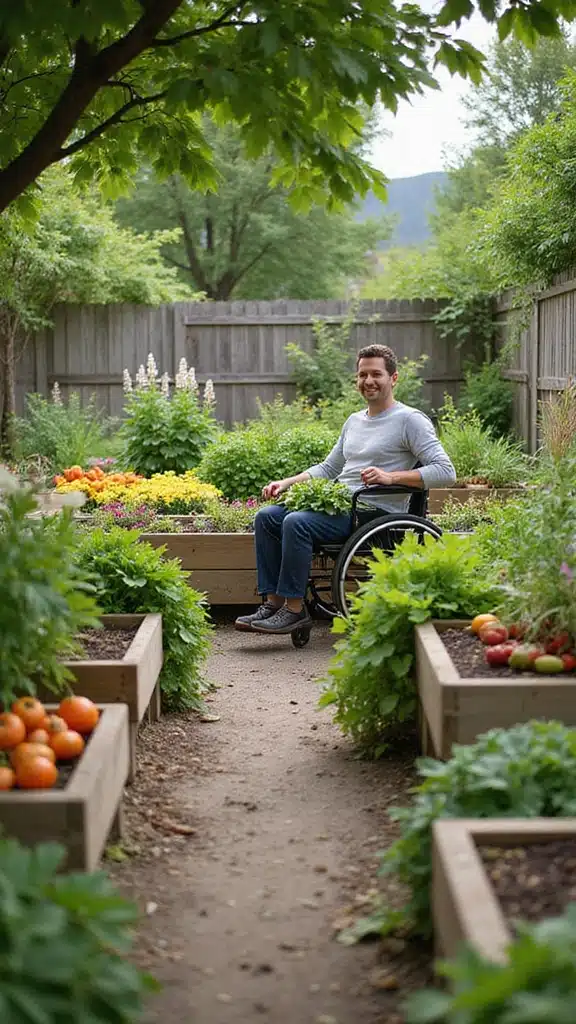
Making your raised vegetable garden accessible is vital for enjoyment, especially if you’re gardening with kids or have mobility challenges. Adding features like wide pathways, raised edges, or even tiered beds can enhance accessibility.
Consider creating a wider path to allow for easy movement with wheelbarrows or garden carts. A wheelchair-accessible design ensures that everyone can enjoy the garden. Implementing raised edges that serve as seating areas makes it easier to tend to your plants.
To support your efforts in creating a safe and convenient gardening space, consider using non-slip garden pathway mats. These mats provide a stable surface, reducing the risk of slips and falls while navigating your garden.
Additionally, incorporating vertical gardening options can greatly enhance accessibility. A great choice is the vertical garden planter, which allows for easier harvesting and maximizes space without requiring extensive bending or reaching.
Lastly, ensure that tools and supplies are always within reach, and consider a comfortable seating solution like the garden kneeler and seat. This handy product features a thickened kneeling pad and tool pouches, making it easier to keep everything organized while providing a comfortable place to sit while you work.
With these features and products, gardening will be a joyful experience for everyone, making it easier to share the fun with family and friends!
6. Vertical Gardening Solutions
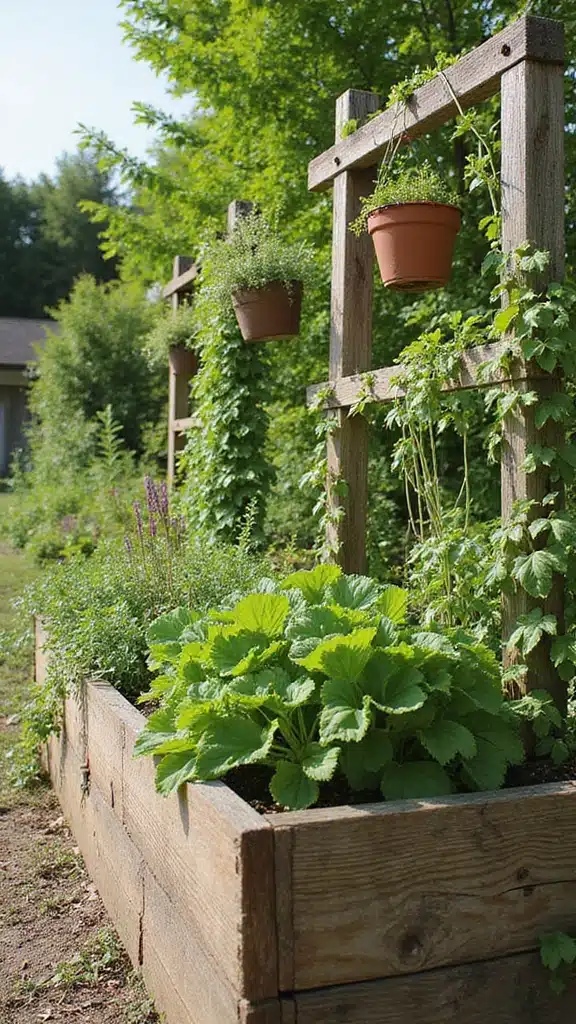
Vertical gardening is an excellent way to maximize space and create an eye-catching design in your raised vegetable garden. By incorporating trellises, wall-mounted planters, or even repurposed old ladders, you can grow climbing plants like peas, cucumbers, and beans!
Not only does vertical gardening save ground space, but it also improves air circulation around your plants, reducing disease risk. This method adds layers to your garden, making it visually appealing.
To create a vertical garden, consider using a wooden trellis for climbing plants. This natural bamboo trellis, measuring 24 inches tall, is sturdy enough to support your climbing plants and comes in a convenient pack of three.
Incorporate wall-mounted planter boxes like the Mr. Stacky 5 tier stackable planter for strawberries, herbs, flowers, and vegetables. This versatile planter helps you utilize vertical space effectively, allowing for an indoor or outdoor vertical garden that showcases a variety of plants.
Don’t forget to add some hanging planters for herbs and small vegetables. This set includes self-watering hanging pots with drainage options, perfect for herbs or smaller veggies.
Experiment with different heights using these solutions to create a dynamic garden landscape. Vertical gardening can make your space feel bigger and allow you to enjoy a broader variety of vegetables!
7. Pest Control Measures
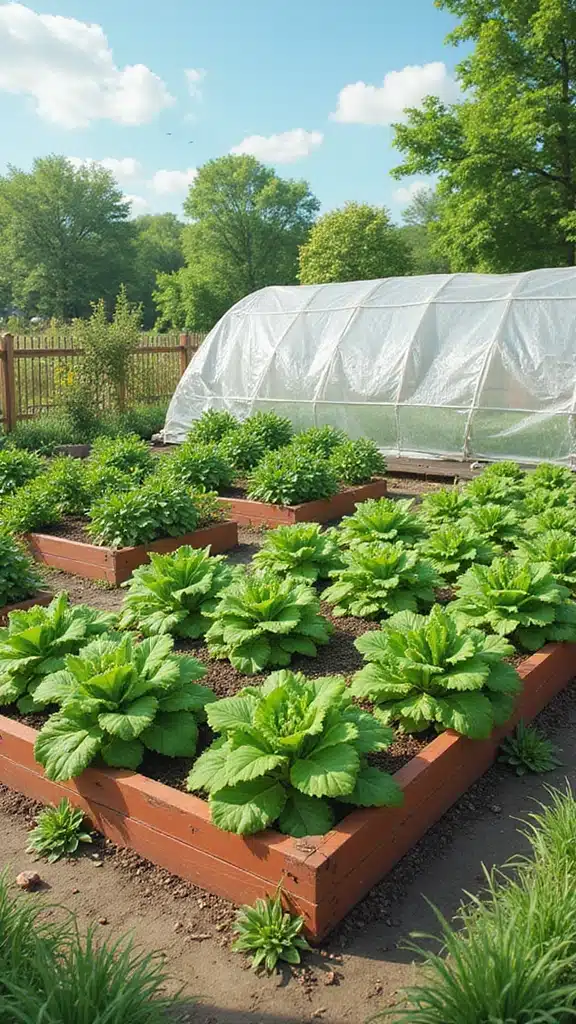
Keeping pests at bay is essential for a successful vegetable garden. Integrated pest management (IPM) strategies can help maintain a healthy garden ecosystem without the need for harsh chemicals.
Start by encouraging beneficial insects like ladybugs and lacewings that prey on pests. A great way to protect these helpful critters is by providing them with a habitat; consider the Beneficial Insect Habitat Kit. This kit includes a bug catcher and a magnified viewer, making it perfect for observing and learning about beneficial insects in your garden.
You can also introduce natural deterrents, such as garlic or pepper sprays, to keep unwanted visitors away. For an effective option, try the Natural Pest Deterrent Spray, which uses peppermint oil to repel common pests like spiders and ants.
Additionally, using row covers can significantly protect your young plants from pests. The Row Covers for Garden is a durable option that ensures your vegetables, fruits, and flowers grow better by providing a safe barrier against harmful insects.
Remember to regularly inspect your plants for signs of pests and, if you find any, remove them manually. With these natural approaches and helpful products, you can keep your garden thriving and ensure a hearty harvest!
8. Crop Rotation Plans
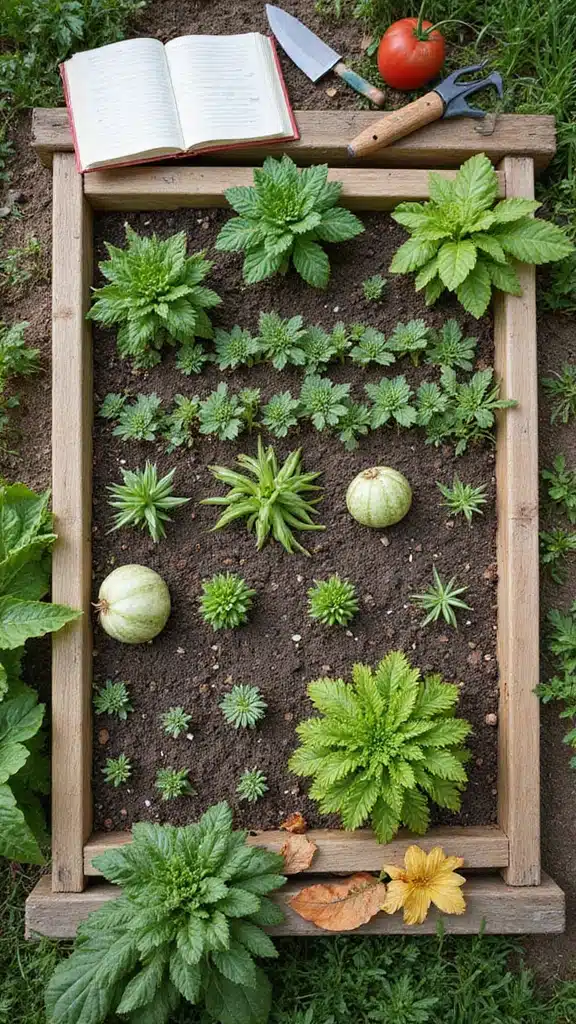
Implementing a crop rotation plan will help maintain soil health and improve productivity in your raised vegetable garden. Different crops deplete specific nutrients in the soil, and rotating them prevents nutrient depletion and reduces pests and diseases.
For example, you might grow leafy greens in one season and follow them with legumes in the next. Legumes can fix nitrogen in the soil, benefiting the following crops. To effectively manage your crop rotation, consider keeping a gardening journal like the Gardener’s Logbook. This will help you track what you plant each season and make informed decisions for the next planting cycle.
Additionally, grouping plants by family makes rotation easier, allowing you to see which crops work best together. Don’t forget to include cover crops during off-seasons to enrich the soil. A great option is the No-Till Cover Crop 13-Seed Mix. This mix contains a variety of seeds that can improve soil structure and fertility, ensuring your garden remains vibrant and productive.
Crop rotation not only keeps your soil healthy but also boosts your harvest throughout the seasons!
9. Aesthetic Enhancements
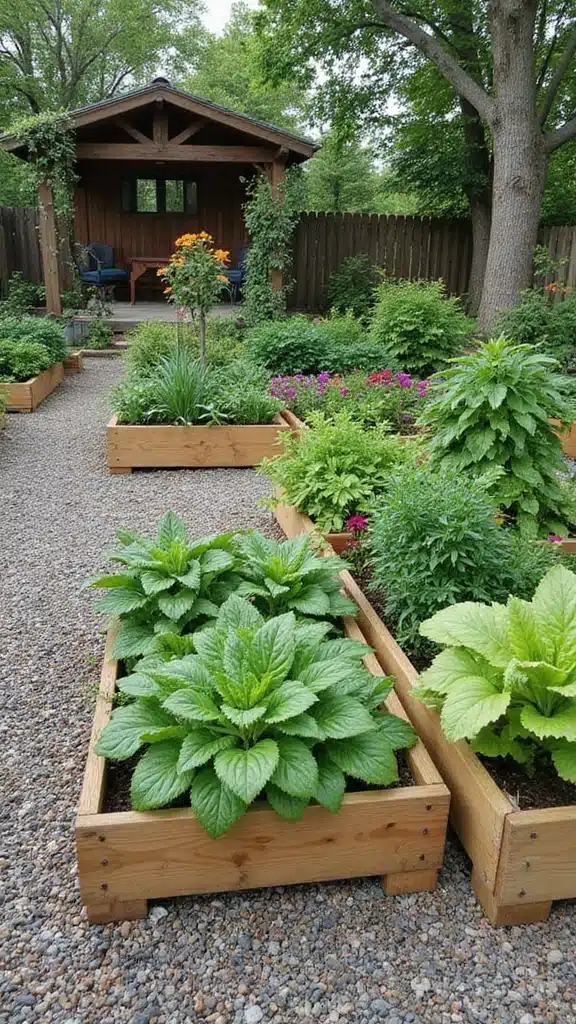
While productivity is key, don’t forget about the aesthetics of your raised vegetable garden bed! Adding decorative touches can make your garden a delightful focal point in your yard.
Consider painting or staining the wood of your raised bed, adding decorative stones along the edges, or even incorporating garden art like sculptures or painted rocks. For an inviting look, colorful flower borders can create a beautiful contrast with your vegetables. You might find that decorative garden stones are a perfect addition, providing a charming outline for your garden while enhancing its visual appeal.
Aesthetic tips to enhance your garden:
– Use attractive containers for herbs or smaller plants. The colorful plant containers are not only vibrant but also functional for starting seedlings or displaying your herbs.
– Add outdoor garden solar lights to illuminate your space with charm during the evening hours, turning your garden into a magical retreat at night.
– Create inviting seating areas to enjoy the view. This will transform your garden from a mere functional space into a stunning outdoor retreat!
With these enhancements, your raised vegetable garden bed can be both productive and visually captivating.
10. Seasonal Planting Calendar
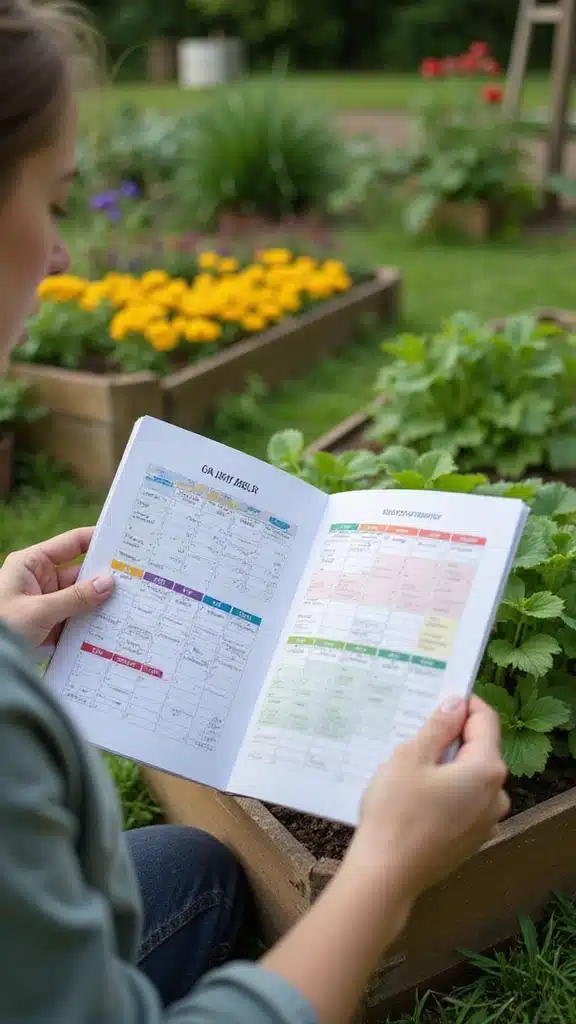
A seasonal planting calendar is an invaluable feature for any vegetable gardener! Knowing what to plant and when can greatly affect your harvest’s success.
To help you manage your planting schedule, consider using a garden planner software. This detailed garden organizer allows you to mark planting dates for each type of vegetable, making it easy to visualize your gardening plan.
It’s also essential to include information on succession planting for continuous harvests. For this, a seasonal planting calendar poster can be particularly helpful. This perpetual lunar cycle calendar will guide you on optimal times for gardening activities, ensuring you make the most of each planting season.
Additionally, adjust your planting schedule for local frost dates and optimal growing conditions. A resource like the frost date guide book can provide invaluable insights into when to plant and protect your crops, giving you peace of mind as you plan for your garden.
By maintaining a seasonal calendar with these tools, you can ensure a bountiful and varied harvest throughout the year!
Conclusion

Creating a successful DIY raised vegetable garden bed involves careful planning and the right features to maximize productivity. By incorporating these must-have elements, you can enjoy a flourishing garden that not only looks great but yields a bountiful harvest.
Whether you’re a seasoned gardener or just starting out, these tips will help you create a thriving vegetable garden you can be proud of. Happy gardening!
Note: We aim to provide accurate product links, but some may occasionally expire or become unavailable. If this happens, please search directly on Amazon for the product or a suitable alternative.
This post contains Amazon affiliate links, meaning I may earn a small commission if you purchase through my links, at no extra cost to you.



